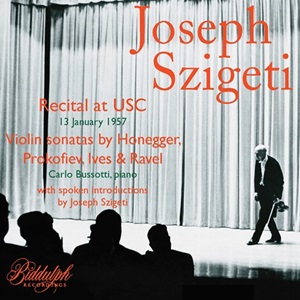
Joseph Szigeti (violin)
Recital at USC, 1957
Arthur Honegger (1892-1955)
Violin Sonata No 1, H17 (1918)
Sergei Prokofiev (1891-1953)
Sonata for solo violin, Op 115 (1947)
Charles Ives (1874-1954)
Violin Sonata No 4 ‘Children’s Day at the Camp Meeting’ (1916)
Maurice Ravel (1875-1937)
Violin Sonata in G (1923-27)
Carlo Busotti (piano)
rec. 1957, Hancock Auditorium, University of Southern California
Biddulph 85039-2 [72]
I have had quite enough of critics writing about Szigeti’s ‘eloquent and patrician’ qualities, as the sleeve note writer does here in his booklet that accompanies yet another example of the violinist’s woeful performances in the late 1950s. I’ve even done it myself. There’s a wish fulfilment cum wilful deafness about this kind of criticism. You can’t berate other musicians for performing when their technical competence has long since deserted them and yet deify Szigeti for his phrasing and musicality when he could barely sustain his bowing. It’s one or the other – not both.
This disc preserves a recital given on 13 January 1957 in the Hancock Auditorium, University of Southern California, one of a series of three different recitals, given on successive evenings, that Szigeti toured during the 1956-57 season. Szigeti recorded all four of the works preserved here in the studio, but he also played Vaughan Williams’ Violin Sonata in the sequence. Normally I’d express disappointment that his performance doesn’t seem to have survived, but perhaps on this occasion it’s for the best that it hasn’t.
Szigeti recorded Honegger’s Violin Sonata No 1 for Mercury in 1959 in a series of concerto and sonata traversals that constituted one of the most wretched bodies of recordings ever made by a major artist (review). His miserable decline is also documented in a Sony box (review) where he recorded the Prokofiev Sonata for solo violin and Ravel’s Sonata, two of the works he played in the university concert. Let’s leave it at this: in the Honegger his bowing is deeply compromised by illness, his tone – never remotely opulent – is now ungrateful, metallic and grating, and intonation wanders. His vibrato’s wideness sabotages the threnodic introduction to the finale and whilst he finds the faster music easier, it’s approximate and smeary.
Prokofiev’s Sonata is at its diciest in the slow movement, where his bowing once again lets him down and where there are examples of avoidable string touching. Tonally, his responses are very torpid. One of the saving graces of this disc is the series of spoken introductions Szigeti recorded for these four sonatas for Fred Maroth which were taped by Radio Lausanne in January 1966, and which Maroth spliced to the recital tapes and distributed to American radio stations. No one doubts Szigeti’s contribution to modern violin repertoire, or his perceptive and articulate awareness of the music he essayed. He talks of ‘realising latent ideas’ in the Prokofiev and he duly plays the fanfare figures in unison and finds drone effects. These are creative decisions but are weakly applied.
Ives’ Fourth Sonata was brought to Szigeti’s attention by Henry Cowell, whose own First Sonata of 1945 Szigeti recorded. Szigeti played the Ives before it had been published, which was admirable of him, but his frailties of tone and uncertainties in shifting made no more of a case for it than had his studio recording. The fact is that this was a work tailor-made for someone like Louis Kaufman. The only performance that made some impression on me was the Ravel, which he’d played with the composer in New York in 1928. Szigeti and his excellent pianist in these college performances, Carlo Bussotti, played the Ravel at two thirds of their recitals – information imparted by the violinist in his spoken introduction to the work. He’d recorded it for Columbia (now Sony) and that too preserved something of his better qualities. Though his tone and vibrato are no longer under real control in the USC recital, his understated and sinuous approach to the Blues second movement still preserves something of his perceptive understanding, though in rather more shadowy outline.
The close recording in a small hall exacerbates his metallic tone and the imprecisions of his bowing, but he receives admiring applause.
What good does it do even so great an artist as Szigeti to be represented, as he has increasingly over the last couple of years, by his worst recordings and broadcasts? Do we really want to hear feeble tone, wretched intonation, and bowing calamities? Are we really going to keep praising his qualities of patrician phrasing when they are unsupported by any kind of rigorous technique? Isn’t this a case of musical necrophilia? Isn’t it fetishistic?
Biddulph is certainly not the only offender – see Eloquence, Sony and Meloclassic too. I’ll always love Szigeti’s recordings of the 1920s, 30s and (mostly) 40s. But it’s high time there was a moratorium on his late recordings and quite frankly no recital made after 1955 (and I’m being very generous) should be released from now on.
Jonathan Woolf
Help us financially by purchasing from



















